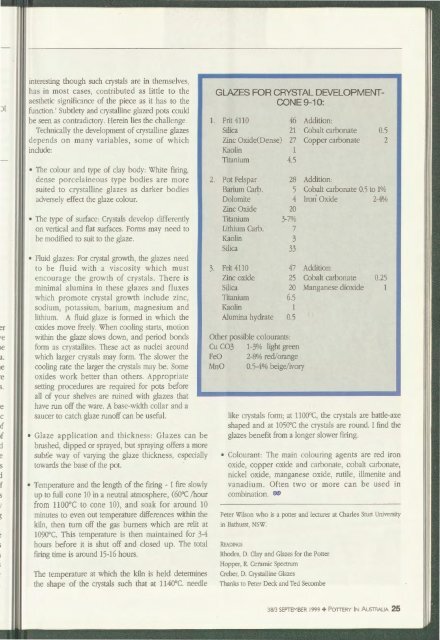Pottery In Australia Vol 38 No 3 September 1999
You also want an ePaper? Increase the reach of your titles
YUMPU automatically turns print PDFs into web optimized ePapers that Google loves.
! • The<br />
t<br />
r<br />
e<br />
e<br />
.<br />
e<br />
e<br />
.<br />
f<br />
interesting though such crystals are in themselves,<br />
has in most cases, contributed as little to the<br />
aesthetic significance of the piece as it has to the<br />
function.' Subtlety and crystalline glazed pots could<br />
be seen as contradictory. Herein lies the challenge.<br />
Technically the development of crystalline glazes<br />
depends on many variables, some of which<br />
include:<br />
colour and type of clay body: White firing,<br />
dense porcelaineous type bodies are more<br />
suited to crystalline glazes as darker bodies<br />
adversely effect the glaze colour.<br />
• The type of surface: Crystals develop differently<br />
on vertical and flat surfaces. Forms may need to<br />
be modified to suit to the glaze.<br />
• Fluid glazes: For crystal growth, the glazes need<br />
to be fluid with a viscosity which must<br />
encourage the growth of crystals. There is<br />
minimal alumina in these glazes and fluxes<br />
which promote crystal growth include zinc,<br />
odium, potassium, barium, magnesium and<br />
lithium. A fluid glaze is formed in which the<br />
oxides move freely. When cooling tarts, motion<br />
within the glaze slows down, and period bonds<br />
form as crystallites. These act as nuclei around<br />
which larger crystals may form. The slower the<br />
cooling rate the larger the crystals may be. Some<br />
oxide work better than others. Appropriate<br />
setting procedures are required for pots before<br />
all of your shelves are ruined with glazes that<br />
have run off the ware. A base-width collar and a<br />
saucer to catch glaze runoff can be useful.<br />
• Glaze application and thickness: Glazes can be<br />
brushed, dipped or sprayed, but spraying offers a more<br />
sub~:e way of varying the glaze thickness, especially<br />
towards the base of the pot.<br />
• Temperature and the length of the firing - I fire slowly<br />
up to full cone 10 in a neutral atmosphere, (60°C /hour<br />
from 1100°C to cone 10), and soak for around 10<br />
minutes to even out temperature differences within the<br />
kiln, then turn off the gas burners which are relit at<br />
1090°C. This temperature is then maintained for 3-4<br />
hours before it is shut off and closed up. The total<br />
firing time is around 15-16 hours.<br />
The temperature at which the kiln is held determines<br />
the shape of the crystals such that at 1140°C. needle<br />
GLAZES FOR CRYSTAL DEVELOPMENT-<br />
CONE9-10:<br />
1. Frit4110 46 Addition:<br />
Silica 21 Cobalt carbonate 0.5<br />
Zinc Oxide(Dense) 27 Copper carbonate 2<br />
Kaolin 1<br />
Titanium 4.5<br />
2. Pot Felspar 28 Addition:<br />
Barium Carb. 5 Cobalt carbonate 0.5 to 1%<br />
Dolomite 4 Iron Oxide 2-4%<br />
Zinc Oxide 20<br />
Titanium 3-7%<br />
Lithium Carb.<br />
7<br />
Kaolin 3<br />
Silica 33<br />
3. Frit 4110 47 Addition:<br />
Zinc oxide 25 Cobalt carbonate 0.25<br />
Silica 20 Manganese dioxide 1<br />
Titanium 6.5<br />
Kaolin<br />
Alumina hydrate 0.5<br />
Other possible colourants:<br />
Cu C03 1-3% light green<br />
FeO 2-8% red. 1 orange<br />
MnO 0.5-4% beige, irn1y<br />
like crystals form; at 1100°C, the c1ystals are battle-axe<br />
shaped and at 1050°C the crystals are round. I find the<br />
glazes benefit from a longer slower firing.<br />
• Colourant: The main colouring agents are red iron<br />
oxide, copper oxide and carbonate, cobalt carbonate,<br />
nickel oxide, manganese oxide, rutile, illmenite and<br />
vanadium. Often two or more can be used in<br />
combination. oo<br />
Peter Wilson who is a potter and lecturer at Charles Sturt University<br />
in Bathurst, SW.<br />
READI:'\G<br />
Rhodes, D. Clay and Glazes for the Potter<br />
Hopper, R. Ceramic Spectrum<br />
Creber, D. Crystalline Glazes<br />
Thanks to Peter Deck and Ted Secombe<br />
<strong>38</strong>/3 SEPTEMBER <strong>1999</strong> + POTTERY IN AUSTRALIA 25

















